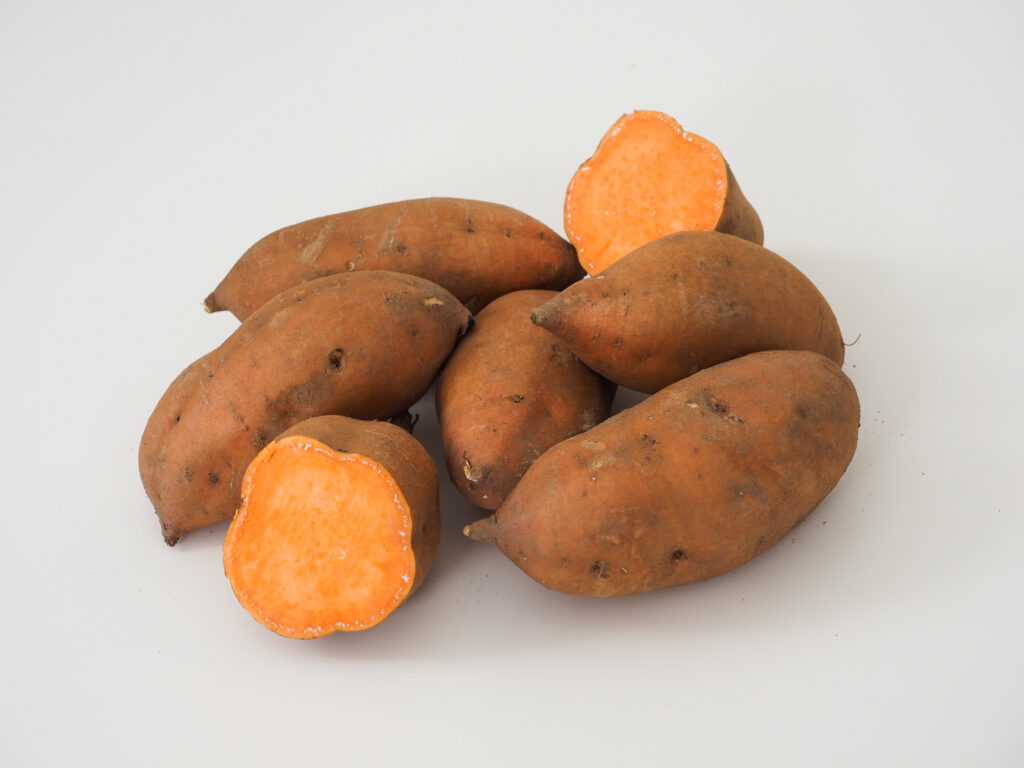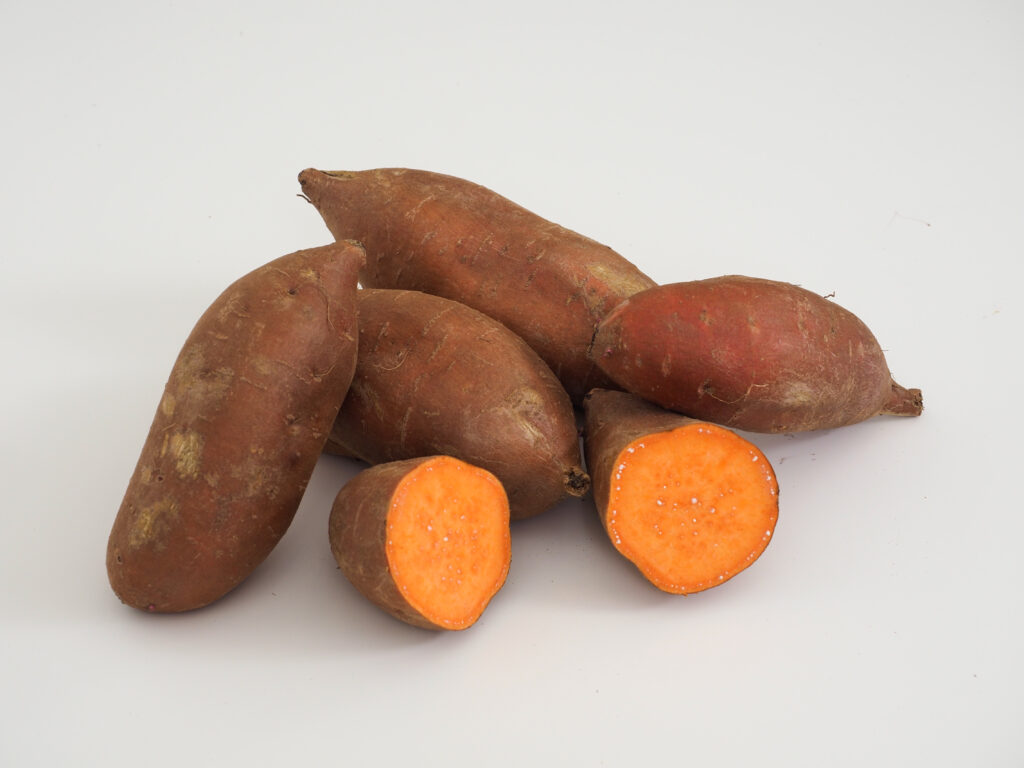Sweetpotato Cultivar Selection and Information
Learn more about considerations for sweetpotato cultivar selection and additional information that may be helpful for making selections. For photos of popular tablestock cultivars developed by the LSU AgCenter and for further information visit the LSU AgCenter Sweet Potato Variety Factsheets.
Considerations for Cultivar Selection
Cultivar selection is critical for the production of a successful sweetpotato crop. Like many aspects of sweetpotato production, there are multiple factors to consider, and often decisions made are specific to particular conditions and needs of growers. However, ultimately, the selection of a particular cultivar is dependent on the economics associated with production and ensuring a profit for the sweetpotato grower.
Factors largely associated with the economics of production include the price of inputs (pesticides, fertilizer, water, etc.) and prices as dictated by market demands (Jennings et al., 2019). When discussing inputs, it is important to consider differences in cultivars as it pertains to fertilizer ratios (particularly nitrogen), resistance to insects, and resistance to common diseases. Generally, it is beneficial to select cultivars that have resistance to multiple insect species and common diseases as it can decrease the amount of pesticides needed to sustain a high-yielding sweetpotato crop. As for market demand, the price of a particular cultivar can vary dramatically depending on the market and consumer demand (Jennings et al., 2019). Characteristics that may be considered include the color of the flesh and the color of the skin. Thus, growers should consider characteristics that are in demand and select appropriate sweetpotato cultivars to ensure the sale of the sweetpotato crop at an appropriate price.

Credit: Marc Hall (mhall@ncsu.edu)
Further, agronomic characteristics like yield and production time must be considered (Jennings et al., 2019). Specifically, growers often select cultivars that are higher-yielding given that more product will be available for sale. As for production time, cultivars that have shorter times until harvest are often favored for their ability to save on input costs over time. Further, shorter times until harvest are favored as sweetpotatoes can be harvested before temperatures drop below that of the optimum growing temperature (which also often coincides with optimal temperatures for disease incidence).

Credit: Marc Hall (mhall@ncsu.edu)
Other factors that may impact the selection of sweetpotato cultivars include the proportion of misshapen storage roots at harvest, plant production, compatibility with organic production, and length of viability while in storage (Jennings et al., 2019).
Additional Cultivar Information
The below tables have been adapted from the North Carolina Organic Commodities Production Guide: Crop Production Management- Sweetpotatoes, the LSU AgCenter Sweet Potato Variety Factsheets, and “Screening Sweetpotato Genotypes for Resistance to a North Carolina Isolate of Meloidogyne enterolobii” by Schwarz et al., 2021.
Table 1. Characteristics of different sweet potato cultivars commonly grown in the United States. Focus on the cultivar origin, agronomic characteristics, flesh color, and skin color.
Table Scale: Yield: VH = Very High, H = High, A = Average, BA = Below Average. Days to Harvest: E = Early (90 – 100 days after planting), M = Midseason (101 – 115 days after planting), L = Late (>115 days after planting). Plant Production: E = Early, M = Middle, L = Late, VH = Very High Plant Production, H = High Plant Production, A = Average Plant Production.
| Sweet Potato Cultivar | Cultivar Origin | Yield | Days to Harvest | Plant Production | Flesh Color | Skin Color |
|---|---|---|---|---|---|---|
| Averre (NC05-198) | North Carolina State University | VH | E | E-H | Orange | Light Rose |
| Bayou Belle | Louisiana State University | VH | E | E-H | Deep Orange | Red to Purple |
| Beauregard | Louisiana State University | H | E | E-H | Moderately Deep Orange | Light Rose |
| Bellevue | Louisiana State University | A-VH | M | A | Bright Orange | Copper |
| Bonita | Louisiana State University | A | M-L | E-H | White, Tinge of Yellow | Light Tan, Pink Cast at Harvest |
| Burgundy | Louisiana State University | BA | M-L | A | Deep Orange | Red-Brown (Burgundy) |
| Centennial | Louisiana State University | Orange | Copper | |||
| Covington | North Carolina State University | H | M | L-A | Moderately Deep Orange | Light to Medium Rose |
| Diane | Heirloom | H | M-L | VH | Deep Orange | Dark Red |
| Evangeline | Louisiana State University | H | M | ML-A | Intense, Deep Orange | Light Rose |
| Hernandez | Louisiana State University | Deep Orange | Red | |||
| Jewel | North Carolina State University | A | M | E-H | Orange | Copper |
| Mahon | Orange | Rose | ||||
| Murasaki-29 | Louisiana State University | A | L | E-VH | White | Dark Purple |
| NC04-531 | North Carolina State University | BA | L | M-H | Orange | Dark Rose |
| O’Henry | White | Cream | ||||
| Orleans | Louisiana State University | H | E | EM-H | Moderately Deep Orange | Light Rose |
| Porto Rico | North Carolina State University | BA | L | E-VH | Salmon | Copper |
| White Bonita | Louisiana State University | White to Light Cream | Light Tan |
Table 2. Characteristics of different sweet potato cultivars commonly grown in the United States. Focus on susceptibility or resistance of cultivars to various plant diseases and insect pests, particularly wilts, blights, and rots. Wireworm Diabrotica Systena (WDS) Complex includes insects such as wireworms, Diabrotica or cucumber beetles, Systena or flea beetles, and sweetpotato flea beetle (Chaetocnema confines).
Table Scale: R = Resistant, S = Susceptible, I = Intermediate, HR = Highly Resistant, MR = Moderately Resistant, MS = Moderately Susceptible, – = Unknown.
| Sweet Potato Cultivar | Fusarium Wilt | Sclerotial Blight | Soil Rot | Rhizopus Soft Rot | Fusarium Root Rot | Bacterial Root Rot | WDS Complex | Flea Beetle |
|---|---|---|---|---|---|---|---|---|
| Averre (NC05-198) | R | - | MR | - | -- | - | S | S |
| Bayou Belle | R | - | I-R | R | - | S | S | S |
| Beauregard | R | I | R-I | R | R | S | S | S |
| Bellevue | R | I | R | I | I | S | S | S |
| Bonita | I-R | - | I | S | S-I | S | S | S |
| Burgundy | R | - | I-R | S | - | S | ||
| Centennial | I-R | I-S | S | - | I | R | ||
| Covington | R | - | I-R | I | - | - | S | MS |
| Diane | I | S | R | S | - | - | MS | - |
| Evangeline | R | - | I-R | R | R | S | S | S |
| Hernandez | I-R | - | R-I | I-S | I | R | ||
| Jewel | R | I | S | I | I | I | S | S |
| Mahon | - | - | - | - | - | - | ||
| Murasaki-29 | R | I-R | R | R | MR | MR | ||
| NC04-531 | R | - | MR | - | - | - | MR | MR |
| O’Henry | R | I | R-I | R | R | S | ||
| Orleans | R | - | R-I | R | R | S | S | S |
| Porto Rico | S | S | S | - | R-I | R | S | S |
| White Bonita |
Table 3. Characteristics of different sweet potato cultivars commonly grown in the United States. Focus on susceptibility or resistance of cultivars to Meloidogyne incognita (Southern Root-Knot Nematode) and Meloidogyne enterolobii (Guava Root-Knot Nematode).
Table Scale: R = Resistant, S = Susceptible, I = Intermediate, HR = Highly Resistant, MR = Moderately Resistant, MS = Moderately Susceptible, – = Unknown.
| Sweet Potato Cultivar | Meloidogyne incognita (Southern Root-Knot Nematode) | Meloidogyne enterolobii (Guava Root-Knot Nematode) |
|---|---|---|
| Averre (NC05-198) | S | S |
| Bayou Belle | I-R | S |
| Beauregard | S | S |
| Bellevue | HR | S |
| Bonita | R | S |
| Burgundy | R | S |
| Centennial | S | R |
| Covington | R | S |
| Diane | - | |
| Evangeline | HR | I-S |
| Hernandez | R-I | S |
| Jewel | I-R | R |
| Mahon | S | |
| Murasaki-29 | HR | R |
| NC04-531 | R | S |
| O’Henry | S | |
| Orleans | S | S |
| Porto Rico | I-S | - |
| White Bonita | - |